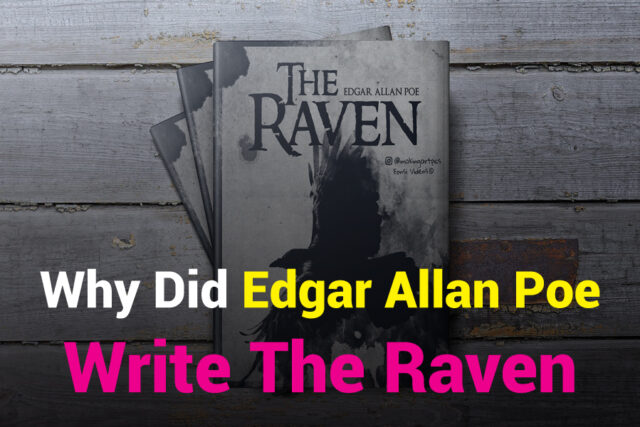In the annals of American literature, few names resonate as profoundly as Edgar Allan Poe. A master of the macabre, Poe’s works have captivated generations of readers with their haunting imagery, psychological depth, and exploration of the human psyche’s darkest recesses. Among his most celebrated creations stands “The Raven,” a poem that has transcended the boundaries of its era and etched itself into the collective consciousness of literary enthusiasts worldwide.
Poe’s life was a tapestry woven with tragedy, genius, and an unwavering pursuit of artistic expression. Born in Boston in 1809, he endured a tumultuous childhood marked by the loss of his parents and a subsequent upbringing by a wealthy merchant’s family. Despite the challenges he faced, Poe’s literary prowess blossomed, and he became renowned for his masterful command of language, his ability to evoke emotions, and his innovative storytelling techniques.
The Background Of “The Raven”
“The Raven” tells the story of a grieving man who is visited by a raven, a bird of ill omen, on a dreary night. The raven’s repetitive utterance of “Nevermore” drives the narrator into a state of madness as he laments the loss of his beloved Lenore. The poem’s dark and melancholic tone, coupled with its haunting imagery, has made it a literary masterpiece that continues to captivate readers to this day.
Analysis Of The Poem’s Themes And Motifs
“The Raven” is a rich tapestry of themes and motifs, each woven intricately into the fabric of the poem. The most prominent theme is that of grief and loss as the narrator grapples with the death of his beloved Lenore. The raven’s ominous presence and its repetitive refrain of “Nevermore” symbolize the finality of death and the futility of hope.
Other prevalent themes include:
- Madness and the descent into insanity
- The power of the human mind and its ability to torment itself
- The fragility of the human psyche
- The contrast between the rational and the irrational
Motifs such as the raven itself, the chamber’s interior, and the use of repetition and alliteration contribute to the overall haunting and hypnotic atmosphere of the poem.
Possible Interpretations Of Why Poe Wrote “The Raven”
While the true motivations behind Poe’s creation of “The Raven” remain shrouded in mystery, literary scholars and enthusiasts have put forth various theories and interpretations. Some of the most prominent ones include:
Personal Grief And Loss: Poe had experienced numerous tragedies in his life, including the deaths of his mother, foster mother, and wife, Virginia. “The Raven” could be a reflection of his own grief and the overwhelming sense of loss he felt.
Exploration Of The Human Psyche: Poe was fascinated by the workings of the human mind and its descent into madness. “The Raven” could be a metaphorical exploration of the fragility of the human psyche and the torment it can inflict upon itself.
Critique Of Transcendentalism: Some scholars believe that “The Raven” was Poe’s response to the Transcendentalist movement, which emphasized the inherent goodness of nature and the human soul. The poem’s dark and pessimistic tone could be interpreted as a critique of this philosophy.
Artistic Expression: Poe was a master of the Gothic and the macabre, and “The Raven” could simply be a manifestation of his artistic vision and his desire to create a haunting and memorable work of literature.
Psychological Theories Behind The Poem
In addition to literary interpretations, “The Raven” has also been analyzed through the lens of psychology. Some of the prominent theories include:
- Freudian Interpretation: Psychoanalysts have interpreted the poem as a representation of the human psyche, with the raven symbolizing the id, the narrator representing the ego, and Lenore representing the superego.
- Obsessive-Compulsive Disorder (OCD): The narrator’s fixation on the raven and its repetitive utterance of “Nevermore” could be seen as a manifestation of OCD, where the individual becomes trapped in a cycle of obsessive thoughts and compulsive behaviors.
- Depression And Melancholia: The poem’s pervasive sense of gloom and the narrator’s descent into despair could be interpreted as a reflection of Poe’s own struggles with depression and melancholia.
- Trauma And Post-Traumatic Stress Disorder (PTSD): The raven’s presence could symbolize a traumatic event or experience that continues to haunt the narrator, akin to the symptoms of PTSD.
Poe’s Writing Style And Use Of Symbolism
Poe’s writing style was a harmonious blend of the gothic and the romantic, infused with a touch of the macabre. His works were characterized by meticulous attention to detail, a penchant for symbolism, and a profound exploration of the human psyche’s darkest depths. From the haunting melodies of “The Bells” to the chilling tales of murder and madness in “The Tell-Tale Heart” and “The Black Cat,” Poe’s literary universe was a realm where the lines between reality and the supernatural blurred, inviting readers to confront their deepest fears and confront the mysteries of the human condition.
In “The Raven,” Poe’s mastery of symbolism reached new heights. The raven itself, a harbinger of doom and despair, became a metaphor for the protagonist’s descent into madness and grief over the loss of his beloved Lenore. The repetition of the haunting refrain “Nevermore” echoed the finality of death and the relentless torment of the mourning process, resonating with readers who had experienced similar heartbreak and sorrow.
The Influence Of “The Raven” On Literature And Pop Culture
“The Raven” has left an indelible mark on literature and popular culture, transcending its origins as a poem and becoming a cultural phenomenon. Its influence can be traced in countless works of art, music, and literature, from the haunting melodies of composers like Sergei Rachmaninoff to the gothic imagery of filmmakers like Roger Corman.
The poem’s enduring popularity can be attributed to its universal themes of loss, grief, and the human struggle against the inexorable forces of fate. Its haunting imagery and evocative language have resonated with generations of readers, inspiring countless interpretations and analyses.
Moreover, “The Raven” has become a touchstone for those who seek solace in the depths of their own sorrow, a reminder that even in our darkest moments, the human spirit can find solace in the beauty and power of art.
Criticisms And Controversies Surrounding The Poem
Despite its widespread acclaim, “The Raven” has not been without its critics and controversies. Some have argued that the poem’s reliance on repetition and its melodramatic tone border on the excessive, while others have questioned the depth of its symbolism and the true meaning behind Poe’s cryptic verses.
Additionally, the poem’s portrayal of the protagonist’s descent into madness has sparked debates about mental health and the representation of mental illness in literature. Some have praised Poe for his unflinching exploration of the human psyche, while others have criticized the poem for perpetuating harmful stereotypes and misconceptions.
Regardless of these criticisms, “The Raven” remains a towering achievement in American literature, a testament to Poe’s genius and his ability to capture the essence of the human experience in all its complexity and darkness.
Other Notable Works By Edgar Allan Poe
While “The Raven” may be Poe’s most famous creation, his literary legacy extends far beyond this single poem. His short stories, such as “The Fall of the House of Usher,” “The Masque of the Red Death,” and “The Pit and the Pendulum,” have become cornerstones of the gothic and horror genres, exploring themes of madness, death, and the fragility of the human condition.
Poe’s detective fiction, exemplified by the character of C. Auguste Dupin in stories like “The Murders in the Rue Morgue” and “The Purloined Letter,” laid the foundation for the modern mystery genre and influenced generations of writers, including Sir Arthur Conan Doyle, the creator of Sherlock Holmes.
Furthermore, Poe’s critical essays and literary theories, such as “The Philosophy of Composition” and “The Poetic Principle,” offered invaluable insights into the creative process and the nature of art, cementing his reputation as a literary visionary and a master of his craft.
Conclusion
Despite the numerous interpretations and analyses, “The Raven” remains an enigmatic and captivating work of art. Perhaps Poe’s true genius lies in his ability to create a piece that resonates with readers on multiple levels, inviting them to explore the depths of human emotion, psyche, and experience.
As I delve into the enigma of “The Raven,” I am reminded of the enduring power of literature to evoke emotions, spark discussions, and challenge our perceptions of the world around us. Poe’s masterpiece stands as a testament to the enduring allure of the Gothic and the macabre, and its impact on generations of readers and writers is undeniable.
Suppose you’re as captivated by the enigmatic nature of “The Raven” as I am. In that case, I invite you to explore more of Poe’s works and join the ongoing discourse surrounding his literary legacy. Engage with fellow literature enthusiasts, share your interpretations, and delve deeper into the world of Gothic literature. Together, we can unravel the mysteries at the heart of Poe’s genius and continue to keep his legacy alive for generations to come.














